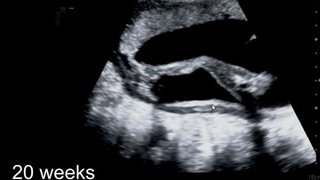Challenges faced with prenatal ultrasound
May 16, 2017

Last week, I watched Jimmy Kimmel’s story about his son’s birth and diagnosis with a congenital heart abnormality that required open-heart surgery. Since then, patients have even asked me specifically if their baby’s heart looks normal on their ultrasound.
Why we do ultrasounds
As many who read this blog know, I perform a lot of ultrasounds, especially in the middle of pregnancy. Women who come to me are looking for reassurance about the health of their baby, and there is a lot of pressure to diagnose potential problems early. When we know about abnormalities, we can better plan for the baby’s birth.
If you’ve watched my ultrasound video, you’ve seen my standard discussion with the family about what we’re looking for on ultrasound. I walk the family through what the baby looks like in utero during every screening exam. Fetal growth, the appearance of all major organs, the amount of fluid around the baby, and the baby’s movements are just some of the things we’re looking at. It’s a methodical approach so we minimize the chance of missing something that is not normal.
Ultrasounds don’t catch everything
The Kimmel’s experience reminds those of us doing prenatal ultrasound that no matter how many ultrasounds we’ve done or how methodical we are, ultrasounds are not perfect. Our eyes aren’t perfect, our machines aren’t perfect, and babies aren’t always in the perfect position to look at.
I always remind patients at the end of my ultrasounds that just because I don’t see anything out of the ordinary, it doesn’t mean your baby is perfectly healthy. But looking normal is still a reason for celebrating. People should be reassured that their baby looks awesome – not perfect, but awesome.
I suspect that the Kimmels, like thousands of other pregnant women in the United States, had an ultrasound during pregnancy. Perhaps even more than one. Data suggest the average pregnant woman has three to four ultrasounds during her prenatal care, with one specifically looking at the anatomy of the fetus. And yet their baby’s heart problem wasn’t found until after birth.
But that’s not so unusual. The overall risk of a congenital heart abnormality in a baby is about one in 100 and it can be increased by your personal and family history. The detection of fetal anomalies with ultrasound during pregnancy can vary greatly. At best, ultrasound picks up about 80 percent of abnormalities.
When we miss something
Over the course of my career, I’ve seen a lot of patients for their ultrasounds. Dr. Santiago-Munoz, a colleague of mine, recently wrote a blog about mistakes in early diagnosis of fetal gender. What she didn’t share is that I initially thought her second daughter was a boy based on an ultrasound test.
For another colleague, I was unable to identify a heart abnormality in one of her twins.
During her second pregnancy, one of her twin sons was born with a milder case of Tetralogy of Fallot, the same condition as Billy Kimmel. As a mother, she wishes she could have had time to mentally prepare for the condition before her sons were born. But as a doctor, she understands that it is impossible for ultrasounds to detect every fetal anomaly.
Fortunately, my colleague, like the Kimmels, delivered in a professional hospital equipped to deal with unexpected problems after delivery.
It moves me to hear about cases like the Kimmel’s, but I’m grateful that nurses and providers picked up on the clinical signs and that there were pediatric cardiologists and surgeons on hand who could provide excellent care to their newborn son, William "Billy" Kimmel.
For more information about pregnancy, labor, and delivery, sign up to receive Your Pregnancy Matters email alerts when we publish new stories. Have a question or an idea for a story? Email us today! You can also make an appointment to see one of our specialists by calling 214-645-8300.










